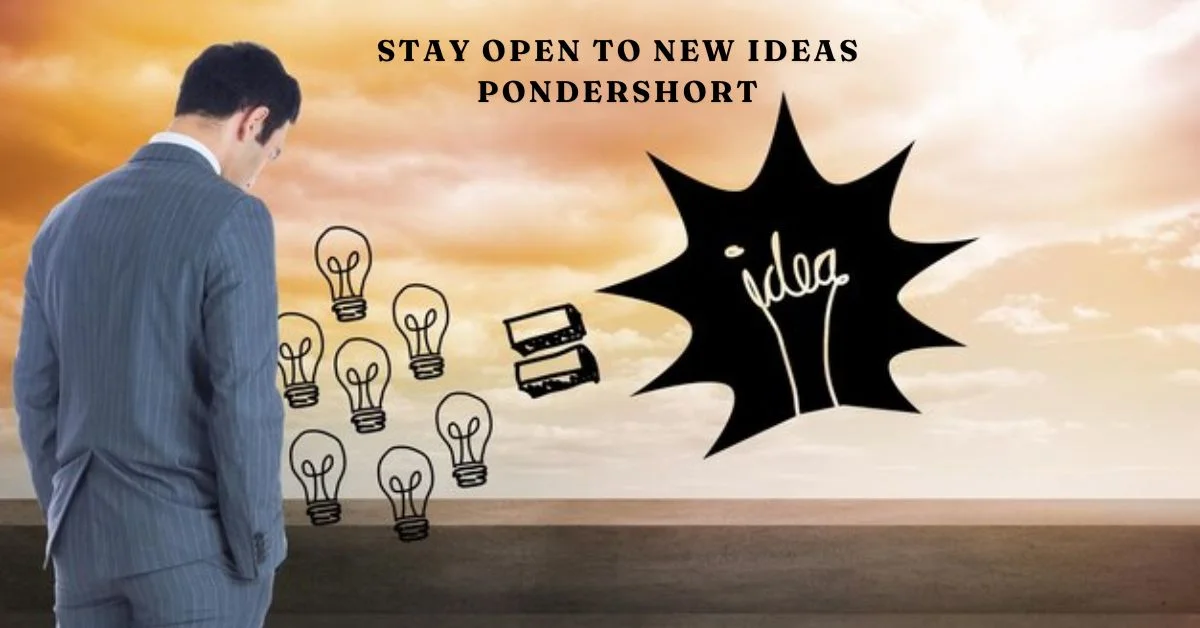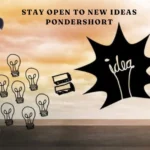Have you ever wondered how a simple shift in mindset can change your life? Staying open to new ideas isn’t just a buzzword—it’s a way of life that can propel you into realms of creativity and innovation you never thought possible. In this article, we’ll embark on a deep dive into the art and science of stay open to new ideas pondershort, exploring practical strategies and real-life examples that illustrate the transformative power of staying open. So, grab a cup of coffee, settle in, and get ready to explore the limitless potential of a curious mind.
Introduction
What Does It Mean to stay open to new ideas pondershort?
Staying open to new ideas is about embracing change, welcoming the unknown, and shedding the limitations of fixed beliefs. It means allowing yourself to explore diverse perspectives, even if they challenge your long-held assumptions. Imagine your mind as a vast, unexplored landscape—every new idea is a fresh path leading to hidden treasures of insight and innovation.
The Relevance in Today’s World
In our fast-paced, ever-evolving society, the ability to adapt and pivot is essential. The world is buzzing with new technologies, shifting social norms, and groundbreaking discoveries. Staying open is not just beneficial; it’s a necessity for personal growth and professional success. Whether you’re an entrepreneur, artist, or simply someone eager to learn, embracing new ideas can lead to breakthroughs that reshape your future.
The Value of Open-Mindedness
Benefits of Embracing stay open to new ideas pondershort
When you keep your mind open, you invite endless opportunities. This approach nurtures creativity, enhances problem-solving skills, and builds resilience against change. Here’s how staying open benefits you:
- Increased Creativity: New ideas can spark creative solutions that were previously unimaginable.
- Enhanced Problem Solving: Facing challenges becomes less daunting when you have a diverse range of perspectives to draw from.
- Personal Growth: Each new concept you explore adds layers to your understanding of the world, fostering continual self-improvement.
The Science of Creativity and Openness
Studies in neuroscience reveal that an open mind stimulates neural pathways associated with creativity. When you expose yourself to new ideas, your brain forms fresh connections, making it easier to think laterally and generate innovative solutions. Think of it as a workout for your brain—the more diverse the exercise, the stronger your mental muscles become.
Overcoming Mental Barriers
Identifying Limiting Beliefs
Before you can embrace new ideas, it’s crucial to identify the barriers holding you back. These barriers often come in the form of limiting beliefs—self-imposed boundaries that restrict your potential. By acknowledging these thought patterns, you create space for new perspectives to flourish.
Recognizing Negative Thought Patterns
Have you ever caught yourself thinking, “I’ve always done it this way” or “This isn’t for me”? These negative patterns can be subtle yet powerful obstacles. Recognizing and challenging these internal narratives is the first step toward a more open and adaptive mindset.
Strategies for Breaking Down Barriers
Breaking free from mental constraints isn’t easy, but it’s definitely possible. Consider these strategies:
- Mindfulness Meditation: Regular meditation can help you become aware of your thoughts and dismantle negative patterns.
- Positive Affirmations: Replace self-doubt with empowering statements that encourage growth.
- Seek Feedback: Embrace constructive criticism as a tool for improvement rather than a threat to your self-worth.
Cultivating an Open Mindset
Daily Practices for Open-Mindedness
Like any skill, open-mindedness can be nurtured with daily habits. Start small by incorporating simple exercises into your routine that encourage exploration and reflection.
Journaling and Reflective Exercises
Journaling is a fantastic way to clear mental clutter and reflect on new ideas. Write about your daily experiences, noting moments when you encountered something unexpected. Ask yourself: What did I learn? How can this idea reshape my perspective?
Engaging with Diverse Perspectives
Step out of your comfort zone by seeking conversations with people who have different viewpoints. Read books, listen to podcasts, and attend events that challenge your current thinking. Each new perspective is a building block in the foundation of a flexible and robust mindset.
Building Curiosity and Resilience
Curiosity is the engine that drives discovery. Nurture it by always asking questions and staying inquisitive about the world around you. Resilience, on the other hand, helps you bounce back when ideas don’t pan out. Together, curiosity and resilience create a powerful duo that fuels lifelong learning.
Stay open to new ideas pondershort in Action
Real-Life Success Stories
Imagine the journey of innovators like Steve Jobs or Elon Musk, who transformed industries by daring to think differently. Their success stories remind us that great ideas often start with a willingness to challenge the status quo. Personal anecdotes from individuals who embraced new ideas can serve as motivational fuel for anyone hesitant to take the leap.
How New Ideas Spark Innovation
Innovation thrives on the collision of diverse thoughts. When people from different backgrounds come together, their unique insights can lead to revolutionary ideas. Think of a bustling brainstorming session where every voice contributes to a mosaic of creativity. This collaborative energy is what drives innovation in every field—from technology to art.
The Role of Failure and Learning
Embracing Mistakes as Opportunities
Failure isn’t the end; it’s merely a stepping stone on the path to success. Every mistake is a lesson in disguise, offering valuable insights that can refine your ideas and strategies. Instead of fearing failure, embrace it as a natural part of the creative process. Ask yourself: What can I learn from this experience? How can I improve next time?
Open-Mindedness in the Workplace
Fostering Creativity in Teams
A workplace that encourages open-mindedness reaps the rewards of diverse thought. Leaders who cultivate an environment where ideas are freely exchanged create teams that are not only innovative but also resilient in the face of change. Imagine a team where brainstorming sessions are like creative jam sessions—every idea, no matter how unconventional, is welcomed and explored.
Leadership and Open Communication
Great leaders know that open communication is the backbone of innovation. By modeling a willingness to listen and learn, leaders inspire their teams to do the same. This culture of transparency and inclusivity leads to a more dynamic, agile, and forward-thinking workplace.
Conclusion
Staying stay open to new ideas pondershort is much more than a trendy phrase—it’s a mindset that can transform your life in countless ways. From personal growth to professional innovation, the benefits of an open mind are profound and far-reaching. By breaking down mental barriers, nurturing curiosity, and embracing failure as a natural part of the learning process, you unlock a world of possibilities.
Remember, every new idea is like a seed that has the potential to bloom into something extraordinary. So, keep questioning, keep exploring, and most importantly, keep an open mind. Your journey to a more creative and fulfilling life starts with a single thought—a thought that dares to be different.
FAQs
What does it mean to be open to new ideas?
Being open to new ideas means actively seeking out diverse perspectives and being willing to challenge your preconceptions. It’s about embracing change and viewing challenges as opportunities for growth.
How can I overcome my fear of trying new things?
Overcoming the fear of new ideas involves acknowledging your limiting beliefs, practicing mindfulness, and gradually exposing yourself to diverse perspectives. Small steps like journaling and seeking feedback can build your confidence.
Why is open-mindedness important in the workplace?
Open-mindedness in the workplace fosters innovation and creativity. When team members feel free to share unconventional ideas, it leads to unique solutions and a more dynamic, adaptable work environment.
What are some practical tips for cultivating an open mindset?
Practical tips include maintaining a regular journaling habit, engaging with people who have different viewpoints, practicing mindfulness meditation, and viewing failures as learning opportunities.
Can being too open to new ideas be a disadvantage?
While staying open is generally beneficial, it’s important to balance openness with critical thinking. Not every new idea is practical, so evaluating ideas thoughtfully is key to making informed decisions.











